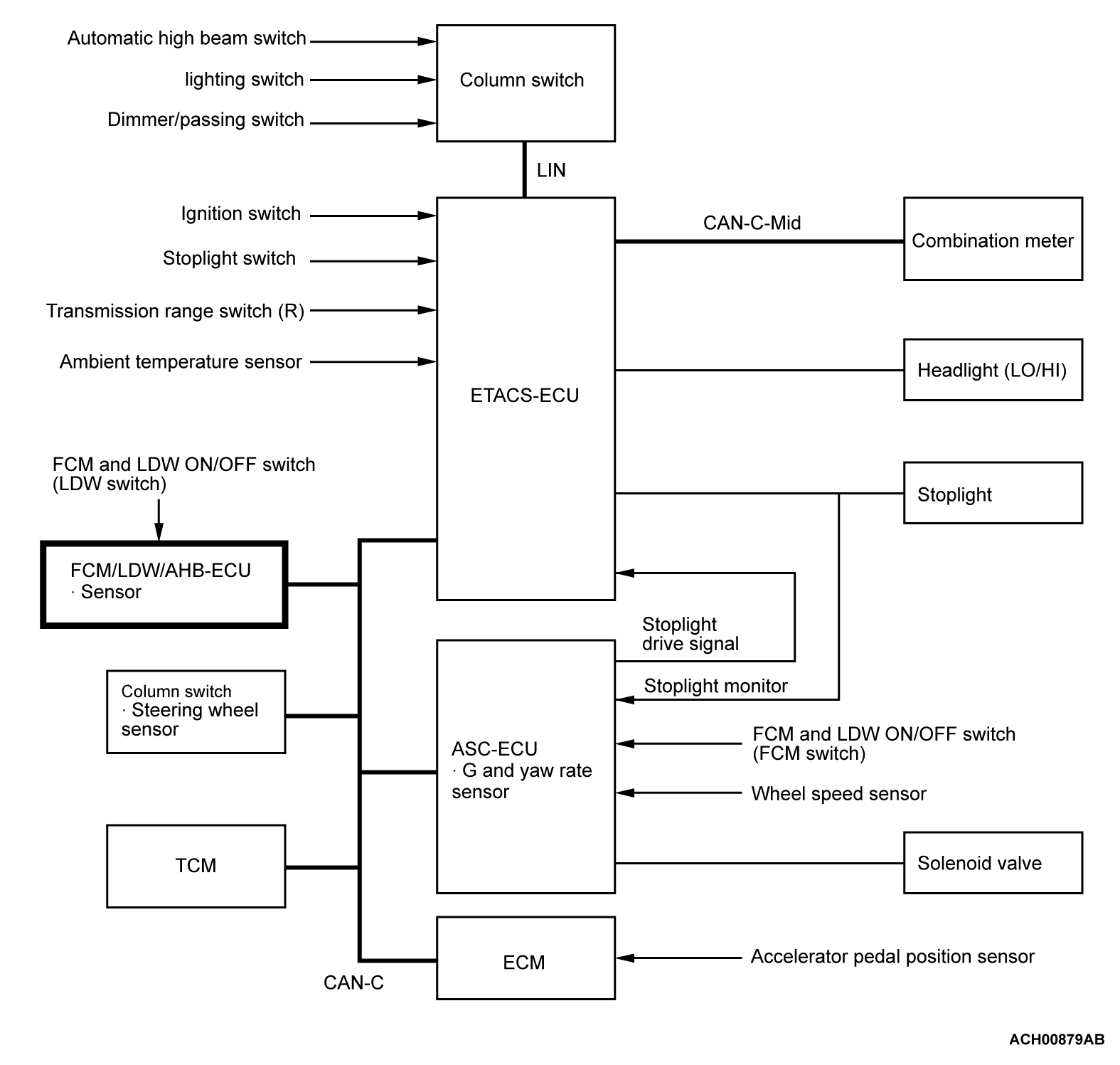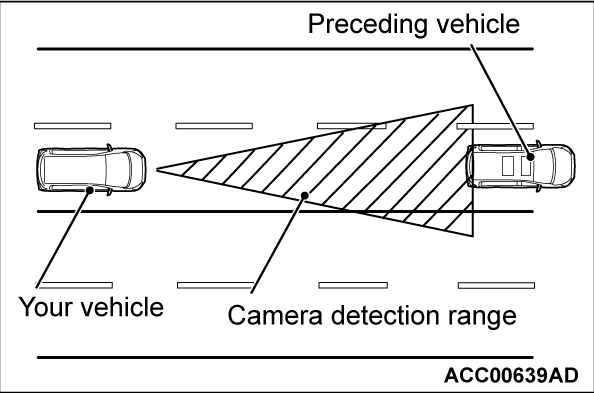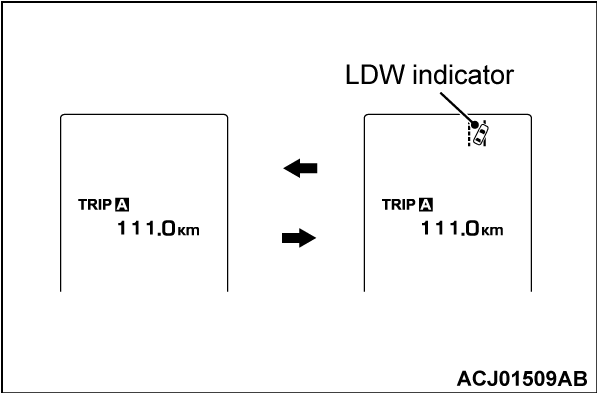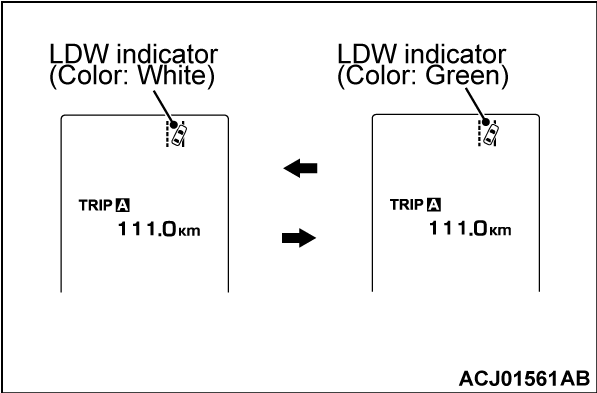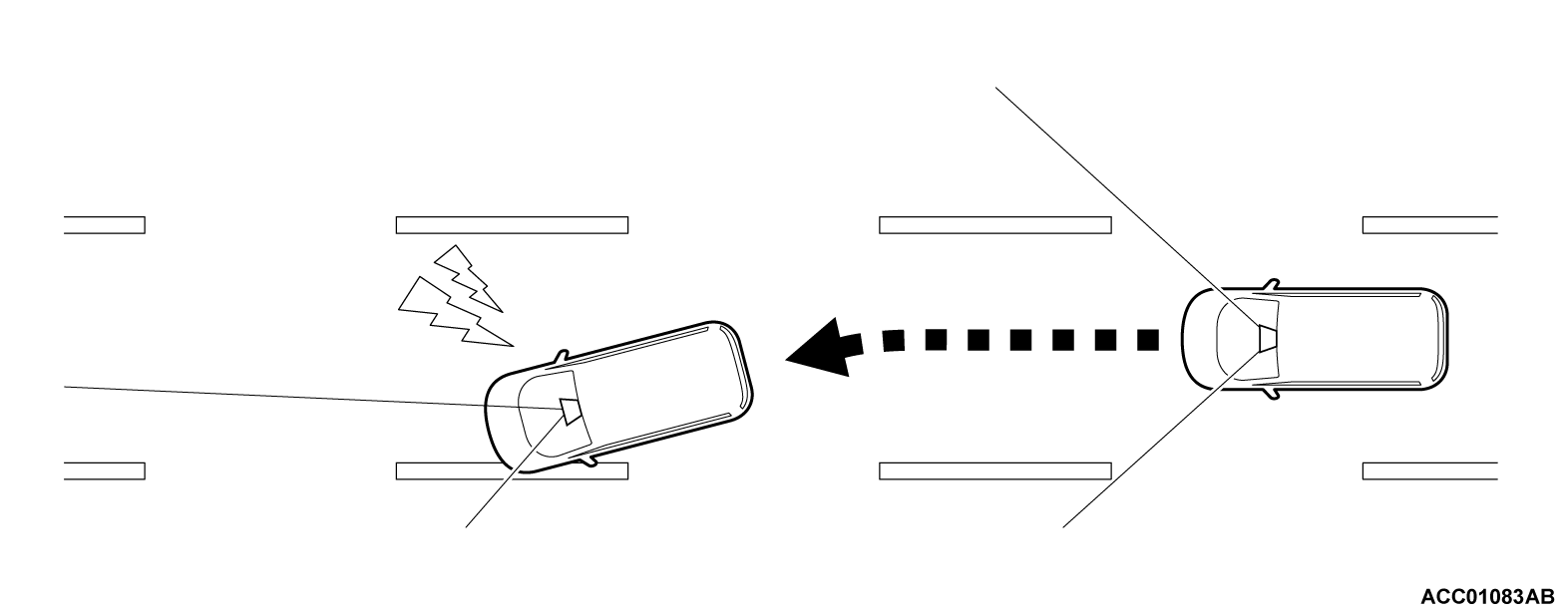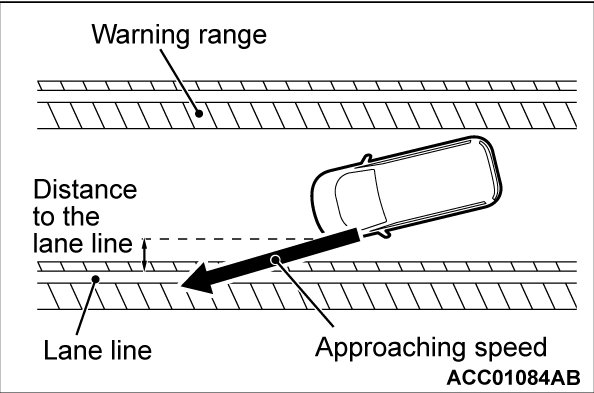GENERAL INFORMATION
| caution | Do not overestimate the FCM. It is never almighty. In addition, the FCM is not designed to avoid driver's inattentive or careless driving or improve the poor vision due to rain or fog.
|
CONSTRUCTION DIAGRAM
Main components and functions
| Component name | Functional Description | |
| FCM/LDW/AHB-ECU (with built-in sensor) |
| |
| ASC-ECU |
| |
| ECM |
| |
| TCM | Informs the ECUs of the selector lever position via CAN communication. | |
| Combination meter | The FCM/LDW/AHB-ECU informs the combination meter of status information and requests it to provide visual warnings. Based on these, the combination meter controls the multi-information display, the indicator lights, the warning lights and the tone alarm. | |
| ETACS-ECU |
| |
| Column switch (with built-in steering wheel sensor) | Informs the ECUs of a steering wheel angle and angular velocity via CAN communication. | |
Fail-safe and self-diagnosis functions
The FCM/LDW/AHB-ECU constantly monitors the input and output signals. If the system detects a malfunction, it will send a failure signal to the combination meter and prohibit the FCM/LDW/automatic high beam system control under circumstances. The combination meter will provide a visual and audible warning to inform the driver of it. The FCM/LDW/AHB-ECU has the following functions for easier system checks.
- Diagnostic trouble code set
- Data list output
- Freeze frame data output
All the above items can be diagnosed using scan tool (M.U.T.-III).
Sensor calibration
If the FCM/LDW/AHB-ECU is replaced or removed and installed, calibration the sensor by using the scan tool (M.U.T.-III).
| note | For how to calibration the sensor, refer to the SERVICE MANUAL. |
FORWARD COLLISION MITIGATION (FCM)
Function
The FCM has the following functions:
| Function | General |
| Forward collision warning function | Activate the visible warning on the combination meter and audible warning when the system determines that a forward collision is imminent. |
| Forward collision mitigation brake system prefill | Increases the brake fluid pressure in advance to enhance the response during the driver's braking operation when the system determines that a forward collision is imminent. |
| Forward collision mitigation brake assist | Advances the brake assist timing when the system determines that a forward collision is imminent. |
| Forward collision mitigation brake | Activates the automatic emergency braking to reduce the vehicle speed when the system determines that a forward collision is not avoidable. |
Operation
The system calculates the distance and the relative velocity between the vehicle traveling ahead or a pedestrian and your vehicle by using a sensor. If the system determines that a straightforward collision is imminent, it will avoid or reduce the injury or damage due to the collision by performing the controls shown in the table below:| Control | Collision is possible | Collision is imminent | Collision is not avoidable | |
| Forward collision warning function | Tone alarm | Sounds | Sounds | Sounds |
| Forward collision mitigation brake system prefill | Increase the brake fluid pressure. | - | - | |
| Forward collision mitigation brake assist | Assists the braking force in accordance with the driver's brake operation. | Assists the braking force in accordance with the driver's brake operation. | Assists the braking force in accordance with the driver's brake operation. | |
| Forward collision mitigation brake* | - | Weak automatic-braking | Strong automatic-braking | |
| note | *: If two seconds elapse after the forward collision mitigation brake stops the vehicle, it can be deactivated automatically. |
FCM AND LDW ON/OFF SWITCH
The FCM and LDW ON/OFF switch is installed at the instrument panel left lower side. You can switch the FCM (on and off) and the warning timing ("FAR", "MIDDLE" and "NEAR") by operating this switch.
How to switch on and off the FCM
- The FCM is toggled between on and off when the FCM and LDW ON/OFF switch is pressed and held. When the FCM is toggled, the system will inform the driver of it by the combination meter LCD display*.
note *: If the FCM is toggled off, "FCM OFF display" will be shown on the combination meter LCD screen. If the FCM is toggled on, a current warning timing will be shown on the combination meter LCD screen.
How to switch the FCM warning timing
- The FCM warning timing is toggled when the FCM and LDW ON/OFF switch is pressed briefly with the FCM activated. When the FCM is toggled, the system will inform the driver of it by the combination meter LCD display.
AUTOMATIC HIGH BEAM SYSTEM
| caution | The automatic high beam system may not work correctly under certain external factors. |
| External factors | Detail |
| Weather | Too bad weather such as fog, snow, heavy rain |
| Windshield glass |
|
| Preceding vehicle or oncoming vehicle |
|
| Road conditions |
|
| Vehicle condition | The vehicle is inclined due to overload, flat tire, or towing, etc. |
| System |
|
Operation
When the FCM/LDW/AHB-ECU (integrated sensor) and the front light sensor sense a light source (illuminant) ahead of the vehicle, the system controls the low beam and high beam automatically to suit each driving situation.
When an oncoming vehicle is approaching
- The system turns on the low-beam when it detects that an oncoming vehicle is approaching.
- The system switches from the low-beam into the high-beam when the oncoming vehicle is out of the detection range of the sensor, which is integrated in the FCM/LDW/AHB-ECU, for a certain period.
| note | The detection range of the sensor, which is integrated in the FCM/LDW/AHB-ECU, depends on its environment. |
When you overtake a preceding vehicle or the system misses it.
- The system turns on the low-beam when it detects that a preceding vehicle is approaching.
- The system switches from the low-beam into the high-beam when the preceding vehicle is out of the detection range of the sensor, which is integrated in the FCM/LDW/AHB-ECU, for a certain period.
| note | The detection range of the sensor, which is integrated in the FCM/LDW/AHB-ECU, depends on its environment. |
Operation conditions for the automatic high beam system
If the condition below is satisfied, the automatic high beam system will be activated.
- Always observe the following procedures from step 1.
- Turn the ignition switch from LOCK (OFF) position to ON position.
- Turn on the low-beam headlights. (Set the lighting switch to "AUTO" or "HEAD" position.)
- Turn on the automatic high beam switch.
Switching conditions between headlight low-beam and high-beam
The system switches the headlight beams as below:
Switching from low-beam to high-beam
- If all of the conditions below are satisfied, the system will switch the headlights from the low-beam to high-beam.
- The vehicle speed is 53 km/h (32.9 mile) or more.
- It is dark in front of or around the vehicle. (Darkness, under which the automatic lighting system turns on the headlights)
- When there are no preceding vehicle or oncoming vehicles
- When there are a few street lights (Including few tunnel lights)
Switching from high-beam to low-beam
- The system switches the headlight beams if any of the conditions below is satisfied.
- The vehicle speed is less than 45 km/h (28.0 mile).
- It is bright in front of or around the vehicle.
- When the taillights of a preceding vehicle or the headlights of an oncoming vehicle are turned on
- When there are many street lights (Including many tunnel lights)
LANE DEPARTURE WARNING SYSTEM (LDW)
Operation
The LDW operates in the three stages below:
| note | The indicator and warning depend on these stages. If predetermined warning conditions are satisfied, the tone alarm will sound. |
- Operation status (LDW: ON)
- Warning monitor status (standby)
- Warning (WARNING L-LANE or WARNING R-LANE)
1. Operation status (LDW: ON)
If all of the conditions below are satisfied, the LDW switch will be active. When the switch is operated with it active, the operation status will be switched between "OFF" (LDW disabled) and "ON" (LDW enabled). (LDW operation status switching function)
- The ignition switch is turned from "OFF" to "ON" or "START"
- The LDW is not defective
2. Warning monitor status (Standby)
If all of the conditions below are satisfied, the LDW will enter the warning monitor status (standby mode).
- The operation status is "ON."
- The LDW is not defective
- Vehicle speed is 65 km/h (40.4 mile) or more
- Seven seconds or more have elapsed since the side turn-signal light (LH or RH) was turned "OFF".
- The LDW camera has recognized a lane successfully or three seconds.
note If lane division lines are dotted-lines, the system also recognizes them one continuous line. - Your vehicle is being driven on a road which radius exceeds 125 m (410.1 ft).
3. Warning (WARNING L-LANE or WARNING R-LANE)
If your vehicle intrudes a warning range, the LDW will provide visual and audible warnings. The warning will be activated for 3 seconds in maximum. Even if the vehicle exits from the range soon, the warning will continue for at least 1 seconds.Variable warning range
The warning range depends on your vehicle's approaching speed to the lane line, or the distance between your vehicle and the lane line as shown.
Deactivating the warning
If your vehicle exits from the warning range or the predetermined warning time elapses, the system will deactivate the warning and return to the standby mode.
Disabling the warning
If a lane width is approximately 2.5 m (8.2 ft) or less or a lane is closed due to construction work, the system will disable the warning to prevent false operation.
Resuming the warning
The LDW stores the range where the repeated warning is inhibited. If a warning is activated once, that range will become active. When your vehicle exits from that range, the warning will be permitted again.
![[Previous]](../../../buttons/fprev.png)
![[Next]](../../../buttons/fnext.png)

